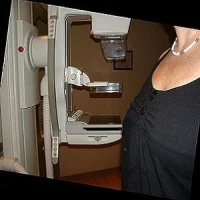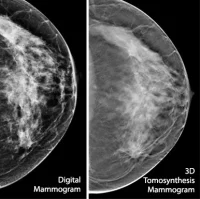A systematic review of available data on dense breasts has found that determinations of breast density can be unreliable and that as many as 19 percent of women are reclassified as dense rather than non-dense or vice versa from one mammogram to the next.
The review, conducted by researchers at UC Davis and other institutions, also found that supplemental diagnostic screenings for women with dense breasts find additional breast cancers but also greatly increase false positive results. However, the review team found no studies that examined women's long-term health outcomes after supplemental screening beyond diagnosis. The findings are reported in the Annals of Internal Medicine.
The review of 24 studies among 2,067 citations examined the evidence on the consistency of breast density category assignment and on supplemental screening beyond standard mammography for women with dense breasts. Breast density has been categorised through the Breast Imaging Reporting and Data System (BI-RADS). Breasts are defined as: a) mostly fatty, b) scattered density, c) consistent density and d) extremely dense.
See Also: Study: Does Breast Density Increase Breast Cancer Risk?
"The number of states mandating that breast density information be reported to patients is increasing," says first author Joy Melnikow, professor and director of the Center for Healthcare Policy and Research at UC Davis. "But the assignment of breast density is not terribly consistent. The policy may be out in front of the science."
Higher breast density modestly increases a woman's risk of developing breast cancer and decreases the sensitivity and specificity of screening mammograms. Women with dense breasts may be offered supplemental screening with ultrasound or magnetic resonance imaging (MRI). However, the review shows this approach may not be supported by strong scientific evidence.
Prof. Melnikow suggests that long-term, rigorous research is needed to better standardise breast density classification and determine whether supplemental screenings provide actual health benefits for women.
Study on Imaging Modalities for Different Densities
In another study, researchers at New York-Presbyterian/Weill Cornell Medical Center investigated which modalities -- 2D mammography (2D), digital breast tomosynthesis (DBT), whole breast sonography (WBS) -- or combination of modalities are optimal for screening depending on breast density. The restrospective study covered screening mammograms (16,789; sorted by modalities and density) performed at the centre in 2013.
See Also: EUSOBI 2015: Implications of Dense Breasts
Results showed that cancer detection is increased by adding WBS to 2D (P = .02) for the overall study population. Recall rate was lowest with 2D + DBT (10.2%, P < .001) and highest with 2D + DBT + WBS (23.6%, P < .001) for the overall study population as well.
"Our principal findings were that women with dense and nondense breasts benefit from reduced recall rate with the addition of DBT. However, for both groups, this benefit is negated with the addition of WBS, which in this study significantly increased recall rate over 2D alone in the whole group and in nondense breasts," says the NYP/Weill Cornell team. The results are published in the journal Clinical Imaging.
Source: University of California - Davis Health System; Clinical Imaging.
Image credit: University of California Regents, 2016
The review, conducted by researchers at UC Davis and other institutions, also found that supplemental diagnostic screenings for women with dense breasts find additional breast cancers but also greatly increase false positive results. However, the review team found no studies that examined women's long-term health outcomes after supplemental screening beyond diagnosis. The findings are reported in the Annals of Internal Medicine.
The review of 24 studies among 2,067 citations examined the evidence on the consistency of breast density category assignment and on supplemental screening beyond standard mammography for women with dense breasts. Breast density has been categorised through the Breast Imaging Reporting and Data System (BI-RADS). Breasts are defined as: a) mostly fatty, b) scattered density, c) consistent density and d) extremely dense.
See Also: Study: Does Breast Density Increase Breast Cancer Risk?
"The number of states mandating that breast density information be reported to patients is increasing," says first author Joy Melnikow, professor and director of the Center for Healthcare Policy and Research at UC Davis. "But the assignment of breast density is not terribly consistent. The policy may be out in front of the science."
Higher breast density modestly increases a woman's risk of developing breast cancer and decreases the sensitivity and specificity of screening mammograms. Women with dense breasts may be offered supplemental screening with ultrasound or magnetic resonance imaging (MRI). However, the review shows this approach may not be supported by strong scientific evidence.
Prof. Melnikow suggests that long-term, rigorous research is needed to better standardise breast density classification and determine whether supplemental screenings provide actual health benefits for women.
Study on Imaging Modalities for Different Densities
In another study, researchers at New York-Presbyterian/Weill Cornell Medical Center investigated which modalities -- 2D mammography (2D), digital breast tomosynthesis (DBT), whole breast sonography (WBS) -- or combination of modalities are optimal for screening depending on breast density. The restrospective study covered screening mammograms (16,789; sorted by modalities and density) performed at the centre in 2013.
See Also: EUSOBI 2015: Implications of Dense Breasts
Results showed that cancer detection is increased by adding WBS to 2D (P = .02) for the overall study population. Recall rate was lowest with 2D + DBT (10.2%, P < .001) and highest with 2D + DBT + WBS (23.6%, P < .001) for the overall study population as well.
"Our principal findings were that women with dense and nondense breasts benefit from reduced recall rate with the addition of DBT. However, for both groups, this benefit is negated with the addition of WBS, which in this study significantly increased recall rate over 2D alone in the whole group and in nondense breasts," says the NYP/Weill Cornell team. The results are published in the journal Clinical Imaging.
Source: University of California - Davis Health System; Clinical Imaging.
Image credit: University of California Regents, 2016
References:
Melnikow J, Fenton JJ, Whitlock EP et al. (2016) Supplemental screening for breast cancer in women with dense breasts: a systematic review for the U.S. Preventive Services Task Force. Ann Intern Med. Published online 12 January 2016 doi:10.7326/M15-1789
Starikov A et al. (2015) 2D mammography, digital breast tomosynthesis, and ultrasound: which should be used for the different breast densities in breast cancer screening
. Clinical Imaging. 6 October 2015. DOI: http://dx.doi.org/10.1016/j.clinimag.2015.10.001
Starikov A et al. (2015) 2D mammography, digital breast tomosynthesis, and ultrasound: which should be used for the different breast densities in breast cancer screening
. Clinical Imaging. 6 October 2015. DOI: http://dx.doi.org/10.1016/j.clinimag.2015.10.001
Latest Articles
healthmanagement, breast cancer screening, breast density, dense breasts, digital breast tomosynthesis, mammography
A systematic review of available data on dense breasts has found that determinations of breast density can be unreliable and that as many as 19 percent of women are reclassified as dense rather than non-dense or vice versa from one mammogram to the next.










